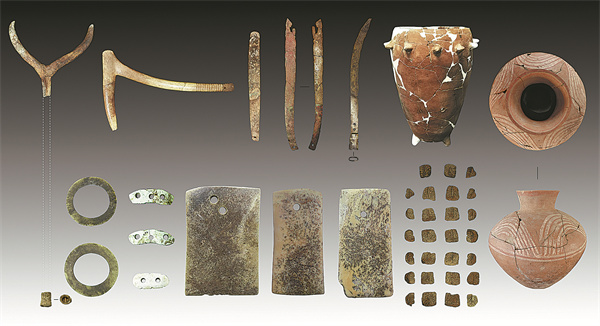Early state tales revealed from 5,000-year-old site

Around 240 kilometers from the Jiaojia excavation site in Jinan, capital of Shandong province, archaeologists have unearthed yet another 5,000-year-old portal to the past at Chengang village in Tengzhou city, in the southern part of the province.
Situated on the banks of Kuohe River, the Gangshang site sprawls over 800,000 square meters and approximately half of the area comprises the ruins of a city, according to Shandong Provincial Institute of Cultural Relics and Archaeology.
By January, excavations had been conducted over 1,100 sq m, leading to rammed earth walls and trenches, 31 tombs, seven houses and other traces of human activities. These provide solid study materials on the origin of the early states, says Zhu Chao, an associate researcher at the institute and team leader of the Gangshang excavation.
"Our excavations and studies show that the civilization, which represents the middle and late phases of Dawenkou Culture, is right at the critical juncture of time when states started to form," Zhu says."The tombs have social grading, which indicates that our ancestors viewed their afterlife as equally important," he adds.
Of the 31 tombs unearthed, there is one 3.3 meters long and 3.2 meters wide, with four bodies. Archaeologists have not been able to confirm the gender of the youngest, but the other three are males. The number and size of jade artifacts buried along with the bodies decline with their age, the obvious evidence of social classification, says Zhu.
Along with 15 jade artifacts, this particular tomb yielded more than 300 pottery items, which account for one-third of the total such relics unearthed at the Gangshang site so far."Unlike the four-body grave, we did not find burial goods in small tombs. In other words, high status meant more fortune," he adds.
Archaeologists have also found remains of chests that contained these burial goods. These were positioned in different parts of the tombs. Some were close to the head, some near the feet and some placed beside the body."The chests are key to studying the burial rites held 5,000 years ago," says Zhu.
Among other intriguing relics found at the site are antler hoes, crocodile bone plates and tortoise shell wares.
Archaeologists have unearthed seven tombs, each housing a man and a woman of approximately the same age. In addition to these, they found three upside-down tripod pottery tombs with remains of unborn babies.
Residential ruins include plinths and holes, where pillars were erected to support houses."The ruins of a city, high-grade tombs and social classification suggest there was state demarcation in this region 5 millennia ago," Zhu says.
Backed by his team members, he is expanding excavation work. They are not sure what exactly they will find in days to come, but have great expectations."The ruins and artifacts unearthed until now offer hands-on knowledge about the origin of an early civilization. We can only hope to find more relics that we can further study as we continue digging," he says.